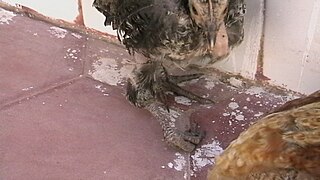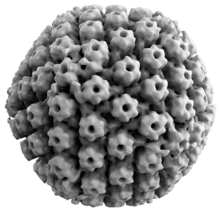Roseolovirus is a genus of viruses in the order Herpesvirales, in the family Herpesviridae, in the subfamily Betaherpesvirinae. There are currently six species in this genus. Diseases associated with this genus include: HHV-6: sixth disease ; HHV-7: symptoms analog to the 'sixth disease'.
Rhadinovirus is a genus of viruses in the order Herpesvirales, in the family Herpesviridae, in the subfamily Gammaherpesvirinae. Humans and other mammals serve as natural hosts. There are 12 species in this genus. Diseases associated with this genus include: Kaposi's sarcoma, primary effusion lymphoma and multicentric Castleman's disease, caused by Human gammaherpesvirus 8 (HHV-8), also known as Kaposi's sarcoma-associated herpesvirus (KSHV). The term rhadino comes from the Latin fragile, referring to the tendency of the viral genome to break apart when it is isolated.
Circoviridae is a family of DNA viruses. Birds and mammals serve as natural hosts. There are 101 species in this family, assigned to 2 genera. Diseases associated with this family include: PCV-2: postweaning multisystemic wasting syndrome; CAV: chicken infectious anemia.

Mardivirus is a genus of viruses in the order Herpesvirales, in the family Herpesviridae, in the subfamily Alphaherpesvirinae. Chickens, turkeys, and quail serve as natural hosts. There are six species in this genus. Diseases associated with this genus include: Marek's disease, which causes asymmetric paralysis of one or more limbs, neurological symptoms, and development of multiple lymphomas that manifest as solid tumors. Gallid herpesvirus 2 is the only one of these viruses known to be pathogenic and due to the antigenic similarity between the three viruses the other two have been used to vaccinate against Marek's disease. These viruses have double stranded DNA genomes with no RNA intermediate.

Alphaherpesvirinae is a subfamily of viruses in the family Herpesviridae, primarily distinguished by reproducing more quickly than other subfamilies in the Herpesviridae. In animal virology the most important herpesviruses belong to the Alphaherpesvirinae. Pseudorabies virus is the causative agent of Aujeszky's disease in pigs and Bovine herpesvirus 1 is the causative agent of bovine infectious rhinotracheitis and pustular vulvovaginitis. Mammals serve as natural hosts. There are currently 45 species in this subfamily, divided among 5 genera with one species unassigned to a genus. Diseases associated with this subfamily include: HHV-1 and HHV-2: skin vesicles or mucosal ulcers, rarely encephalitis and meningitis, HHV-3: chickenpox (varicella) and shingles, GaHV-2: Marek's disease.
Varicellovirus (var′i-sel′ō-vi′rŭs) is a genus of viruses belonging to subfamily Alphaherpesvirinae, a member of family Herpesviridae. Humans and other mammals serve as natural hosts. There are 19 species in this genus. Diseases associated with this genus include: HHV-3—chickenpox (varicella) and shingles; BoHV-1—infectious bovine rhinotracheitis/infectious pustular vulvovaginitis (IPV); and SuHV-1 —Aujesky's disease.

Iltovirus is a genus of viruses in the order Herpesvirales, in the family Herpesviridae, in the subfamily Alphaherpesvirinae. Birds, galliform birds, psittacine birds, chickens, turkeys, and quail serve as natural hosts. There are only two species in this genus. Diseases associated with this genus include: acute respiratory diseases: gaHV-1: infectious laryngotracheitis; psHV-1: Pacheco's disease.

Lymphocryptovirus is a genus of viruses in the order Herpesvirales, in the family Herpesviridae, in the subfamily Gammaherpesvirinae. This genus includes the human-infecting Human gammaherpesvirus 4, as well as viruses that infect both Old World monkeys and New World monkeys. Other names for the Lymphocryptovirus genus include Lymphocryptoviridae and gamma-1 herpesviruses. There are nine species in this genus. Diseases associated with this genus include: mononucleosis, Burkitt's lymphoma, and nasopharyngeal carcinoma.

Orthohepadnavirus is a genus of viruses, in the family Hepadnaviridae. Humans and other mammals serve as natural hosts. There are 12 species in this genus. Diseases associated with this genus include: hepatitis, hepatocellular carcinoma, and cirrhosis.
Muromegalovirus is a genus of viruses in the order Herpesvirales, in the family Herpesviridae, in the subfamily Betaherpesvirinae. Rodents serve as natural hosts. There are three species in this genus. Diseases associated with this genus include: infected peritoneal macrophages, dendritic cells (DC) and hepatocytes, inducing significant pathology in both the spleen and the liver. Murid viruses Murid betaherpesvirus 1 (MuHV-1) and Murid betaherpesvirus 2 (MuHV-2), previously defined as mouse cytomegalovirus (MCMV) and rat cytomegalovirus (RCMV), belong to this genus.
Mastadenovirus is a genus of viruses in the family Adenoviridae. Humans and other mammals serve as natural hosts. There are 51 species in this genus. The genus as a whole includes many very common causes of human infection, estimated to be responsible for 2 to 5% of all respiratory infections, as well as gastrointestinal and eye infections. Symptoms are usually mild.
Alphapapillomavirus is a genus of viruses in the family Papillomaviridae. Humans and monkeys serve as natural hosts. There are 14 species in this genus. Diseases associated with this genus include warts, papillomas, and malignant tumours. The genital-type species known to carry a high risk for malignancy are HPV-16 and 18, and those with a low risk of malignancy are HPV-6 and 11.
Betapapillomavirus is a genus of viruses in the family Papillomaviridae. Human serve as natural hosts. There are six species in this genus. Diseases associated with this genus include warts, papillomas, and malignant tumours.
Etapapillomavirus is a genus of viruses in the family Papillomaviridae. Birds serve as natural hosts. There is only one species in this genus: Etapapillomavirus 1. Diseases associated with this genus include cutaneous lesions.
Gammapapillomavirus is a genus of viruses in the family Papillomaviridae. Human serve as their natural hosts. There are 27 species in this genus. Diseases associated with this genus include warts and papillomas.
Macavirus is a genus of viruses in the order Herpesvirales, in the family Herpesviridae, in the subfamily Gammaherpesvirinae. Mammals serve as natural hosts. There are nine species in this genus. Diseases associated with this genus include: inapparent infection in their reservoir hosts, but fatal lymphoproliferative disease when they infect MCF-susceptible hosts, including cattle, deer, bison, water buffalo and pigs.
Nupapillomavirus is a genus of viruses in the family Papillomaviridae. Humans serve as natural hosts. There is only one species in this genus: Nupapillomavirus 1. Diseases associated with this genus include facial warts. This virus has also been detected in some skin carcinomas and premalignant keratoses.
Percavirus is a genus of viruses in the order Herpesvirales, in the family Herpesviridae, in the subfamily Gammaherpesvirinae. Mammals serve as natural hosts. There are six species in this genus. Diseases associated with this genus include: conjunctivitis, immunosuppression in foals, pneumonia, respiratory disease.
Scutavirus is a genus of viruses in the order Herpesvirales, in the family Herpesviridae, in the subfamily Alphaherpesvirinae. Turtles and tortoises serve as natural hosts. Diseases associated with this genus include fibropapillomatosis.
Batravirus is a genus of viruses in the order Herpesvirales, in the family Alloherpesviridae. Frogs serve as natural hosts. There are three species in this genus. Diseases associated with this genus include: raHV-1: Lucké tumor.





